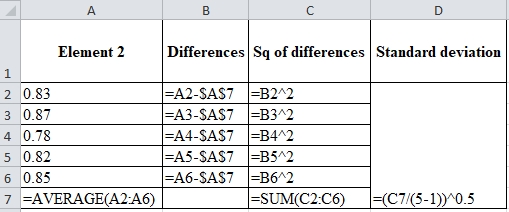
a)
To determine: The standard time for the operation.
Introduction: The amount of the dependency on human effort by an organization in terms of achieving its goals is given by the work design. It is directly linked to the productivity of an organization where good work design helps in achieving high productivity.
a)
Answer to Problem 10P
Explanation of Solution
Given information:
| Element | Performance rating | Observations (minutes per cycles) | Allowance | |||||
| 1 | 2 | 3 | 4 | 5 | 6 | |||
| 1 | 1.1 | 1.2 | 1.17 | 1.16 | 1.22 | 1.24 | 1.15 | 0.15 |
| 2 | 1.15 | 0.83 | 0.87 | 0.78 | 0.82 | 0.85 | 0 | 0.15 |
| 3 | 1.05 | 0.58 | 0.53 | 0.52 | 0.59 | 0.6 | 0.54 | 0.15 |
Formula:
Calculation of standard time of operation:
| Element | Performance rating | Observations (minutes per cycles) | Allowance | Observed time | Normal time | Afjob | Standard time | |||||
| 1 | 2 | 3 | 4 | 5 | 6 | |||||||
| 1 | 1.1 | 1.2 | 1.17 | 1.16 | 1.22 | 1.24 | 1.15 | 0.15 | 1.198 | 1.317 | 1.15 | 1.52 |
| 2 | 1.15 | 0.83 | 0.87 | 0.78 | 0.82 | 0.85 | 0 | 0.15 | 0.83 | 0.954 | 1.15 | 1.10 |
| 3 | 1.05 | 0.58 | 0.53 | 0.52 | 0.59 | 0.6 | 0.54 | 0.15 | 0.564 | 0.592 | 1.15 | 0.68 |
| Standard time for operation | 3.29 | |||||||||||
Excel Worksheet:

Element 1:
Observed time is calculated by taking mean for the 1.2, 1.17, 1.16, 1.22, 1.24 and 1.15 which gives 1.198.
Normal time is calculated by multiplying observed timing, 1.198 and performance rating, 1.1 which yields 1.317 minutes.
Allowance factor is calculated by adding 1 with the allowance factor 0.15 to give 1.15.
Standard time for element 1 is calculated by multiplying normal time of 1.317 minutes with allowance factor of 1.15 which gives 1.52 minutes.
Same process applies for element 2 and 3 which yields the standard times as 1.10 and 0.68. The standard time for operation is obtained by adding 1.52, 1.10 and 1.68 minutes which gives 3.29 minutes.
Hence, the standard time for the operation is 3.29 minutes.
b)
To determine: The number of observations for element 2.
Introduction: The amount of the dependency on human effort by an organization in terms of achieving its goals is given by the work design. It is directly linked to the productivity of an organization where good work design helps in achieving high productivity.
b)
Answer to Problem 10P
Explanation of Solution
Given information:
| Element | Performance rating | Observations (minutes per cycles) | Allowance | |||||
| 1 | 2 | 3 | 4 | 5 | 6 | |||
| 1 | 1.1 | 1.2 | 1.17 | 1.16 | 1.22 | 1.24 | 1.15 | 0.15 |
| 2 | 1.15 | 0.83 | 0.87 | 0.78 | 0.82 | 0.85 | 0 | 0.15 |
| 3 | 1.05 | 0.58 | 0.53 | 0.52 | 0.59 | 0.6 | 0.54 | 0.15 |
Confidence= 95.5%
1% of true value
Formula:
Calculation of number of observations for element A:
In the above formula the sample standard deviation is calculated by,
Calculation of standard deviation:
| Element 2 | Differences | Square of differences | Standard deviation |
| 0.83 | 0 | 0 | 0.0339 |
| 0.87 | 0.04 | 0.0016 | |
| 0.78 | -0.05 | 0.0025 | |
| 0.82 | -0.01 | 0.0001 | |
| 0.85 | 0.02 | 0.0004 | |
| Mean=0.83 | SSQ=0.0046 |
Excel worksheet:

Z value for confidence interval of 95.5% is 2.00.
The confidence interval
- Using z = 2.00:
The number of observations from the standard z table for confidence level of 95.5% is calculated by dividing the product of 2.00 and 0.0339 with product of 0.01 and 0.83 and squaring the resultant which gives 66.7272.
- Using z = 2.01:
The number of observations from the standard z table for confidence level of 95.5% is calculated by dividing the product of 2.01 and 0.0339 with product of 0.01 and 0.83 and squaring the resultant which gives 67.3962.
Hence, the number of observation is 68.
c)
To determine: The number of observations needed to estimate the mean time for element 2 within 0.01 minute of its true value.
Introduction: The amount of the dependency on human effort by an organization in terms of achieving its goals is given by the work design. It is directly linked to the productivity of an organization where good work design helps in achieving high productivity.
c)
Answer to Problem 10P
Explanation of Solution
Given information:
| Element | Performance rating | Observations (minutes per cycles) | Allowance | |||||
| 1 | 2 | 3 | 4 | 5 | 6 | |||
| 1 | 1.1 | 1.2 | 1.17 | 1.16 | 1.22 | 1.24 | 1.15 | 0.15 |
| 2 | 1.15 | 0.83 | 0.87 | 0.78 | 0.82 | 0.85 | 0 | 0.15 |
| 3 | 1.05 | 0.58 | 0.53 | 0.52 | 0.59 | 0.6 | 0.54 | 0.15 |
Confidence= 95.5%
0.10 minute of actual value.
Formula:
Calculation of number of observations for element C:
In the above formula the sample standard deviation is calculated by,
Z value for confidence interval of 95.5% is 2.00.
The confidence interval
- Using z = 2.00:
The number of observations from the standard z table for confidence level of 95.5 is calculated by dividing the product of 2.00 and 0.0339 with 0.01 and squaring the resultant which gives 45.9684.
- Using z = 2.00:
The number of observations from the standard z table for confidence level of 95.5 is calculated by dividing the product of 2.01 and 0.0339 with 0.01 and squaring the resultant which gives 46.4292.
Hence, the number of observations needed to estimate the mean time for element 2 within 0.01 minute of its true value is 46.
Want to see more full solutions like this?
Chapter 7 Solutions
Operations Management (Comp. Instructor's Edition)
- Can you guys help me with this? Thank you! Here's the question: Compared to the CONSTRAINT model, how has the network changed? How do you plan to add contingency to your network? Please answer this thoroughly Here's the what-if scenario: Assume that the LA warehouse becomes temporarily or even indefinitely disabled since facing a large-scale labor disruption. Re-optimize the network considering this new constraint. Here's the scenario comparison analysis: Scenario Constraint Scenario vs What-if Scenario Summary The Constraint Scenario exhibits a higher total cost of $7,424,575.45 compared to the What-if Scenario's total cost of $6,611,905.60, signifying a difference of approximately $812,669.85, which indicates a more expensive operation in the Constraint Scenario. The average service time is slightly higher in the Constraint Scenario (0.72 days vs. 0.70 days), suggesting that the What-if Scenario provides a marginally quicker service. Moreover, the average end-to-end service time…arrow_forwardCan you guys help me with this? Thank you! Here's the question: Compared to the CONSTRAINT model, how has the network changed? How do you plan to add contingency to your network? Please answer this throughly Here's the what-if scenario: Assume that Dallas plant has lost power. It cannot serve the DCs anymore and has to remain locked indefinitely. Re-optimize the network considering this new constraint. Here's the scenario comparison analysis: Scenario Constraint Scenario vs What-if Scenario Summary In comparing the Constraint Scenario to the What-if Scenario, a few key differences highlight the efficiencies evident in the supply chain. Firstly, the total cost in the Constraint Scenario is lower at $7,424,575.45, while the What-if Scenario incurs a total cost of $7,486,369.12, resulting in a cost delta of $61,793.67. Additionally, although both scenarios exhibit the same average service time of 0.72 days, the What-if Scenario has a more favorable average end-to-end service time of 2.41…arrow_forwardEmployee In-Service Training ASSIGNMENT: In-Service Training. The intern is required to plan and implement two in-service training sessions for employees. Each in-service should last at least 10 but not more than 30 minutes and should be given to all employees affected. The preceptor or supervisor/unit manager must approve all in-service topics. 1) One presentation should be related to a policy or procedure of any kind (e.g. proper use of equipment); 2) The second presentation must be related to sanitation or safety. For each in-service presentation, the intern must develop a written class plan and a visual aid (may be a handout, poster, PowerPoint slide presentation, etc.) appropriate to the life experiences, cultural diversity and educational background of the target audience. The intern must also measure behavior change. Note, this cannot be measured by a written pre- and post- test. That would be measuring knowledge. The intern mustactually observe and document that the learners…arrow_forward
- A small furniture manufacturer produces tables and chairs. Each product must go through three stages of the manufacturing process – assembly, finishing, and inspection. Each table requires 3 hours of assembly, 2 hours of finishing, and 1 hour of inspection. The profit per table is $120 while the profit per chair is $80. Currently, each week there are 200 hours of assembly time available, 180 hours of finishing time, and 40 hours of inspection time. Linear programming is to be used to develop a production schedule. Define the variables as follows: T = number of tables produced each week C= number of chairs produced each week According to the above information, what would the objective function be? (a) Maximize T+C (b) Maximize 120T + 80C (c) Maximize 200T+200C (d) Minimize 6T+5C (e) none of the above According to the information provided in Question 17, which of the following would be a necessary constraint in the problem? (a) T+C ≤ 40 (b) T+C ≤ 200 (c) T+C ≤ 180 (d) 120T+80C ≥ 1000…arrow_forwardAs much detail as possible. Dietary Management- Nursing Home Don't add any fill-in-the-blanksarrow_forwardMenu Planning Instructions Use the following questions and points as a guide to completing this assignment. The report should be typed. Give a copy to the facility preceptor. Submit a copy in your Foodservice System Management weekly submission. 1. Are there any federal regulations and state statutes or rules with which they must comply? Ask preceptor about regulations that could prescribe a certain amount of food that must be kept on hand for emergencies, etc. Is the facility accredited by any agency such as Joint Commission? 2. Describe the kind of menu the facility uses (may include standard select menu, menu specific to station, non-select, select, room service, etc.) 3. What type of foodservice does the facility have? This could be various stations to choose from, self-serve, 4. conventional, cook-chill, assembly-serve, etc. Are there things about the facility or system that place a constraint on the menu to be served? Consider how patients/guests are served (e.g. do they serve…arrow_forward
 Management, Loose-Leaf VersionManagementISBN:9781305969308Author:Richard L. DaftPublisher:South-Western College Pub
Management, Loose-Leaf VersionManagementISBN:9781305969308Author:Richard L. DaftPublisher:South-Western College Pub Understanding Management (MindTap Course List)ManagementISBN:9781305502215Author:Richard L. Daft, Dorothy MarcicPublisher:Cengage Learning
Understanding Management (MindTap Course List)ManagementISBN:9781305502215Author:Richard L. Daft, Dorothy MarcicPublisher:Cengage Learning Practical Management ScienceOperations ManagementISBN:9781337406659Author:WINSTON, Wayne L.Publisher:Cengage,
Practical Management ScienceOperations ManagementISBN:9781337406659Author:WINSTON, Wayne L.Publisher:Cengage,



